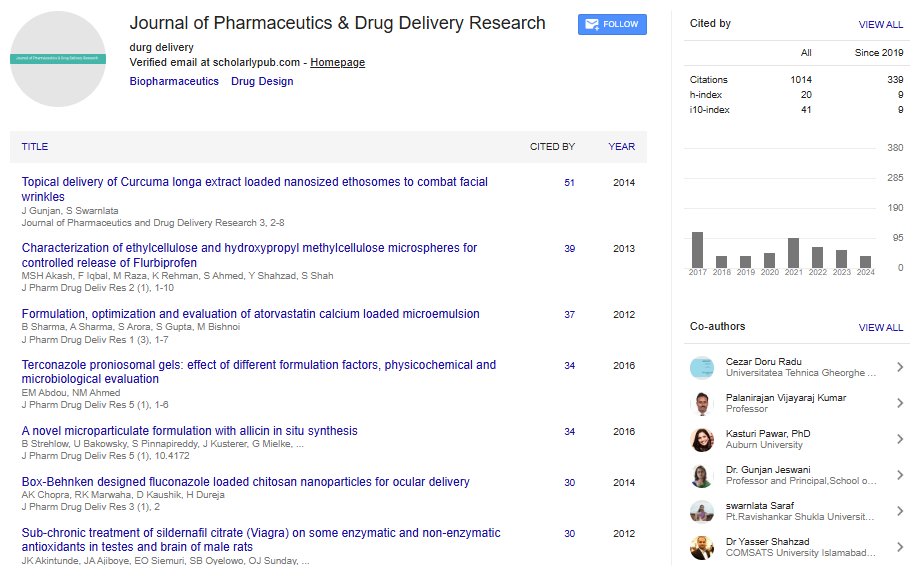Short Communication, J Pharm Drug Deliv Res Vol: 13 Issue: 6
Innovations and Challenges in Modern Pharmaceutics
Rawan Algahtani*
1Department of Pharmaceutics, Najran University, Najran, Saudi Arabia
*Corresponding Author: Rawan Algahtani,
Department of Pharmaceutics, Najran
University, Najran, Saudi Arabia
E-mail: algaht.raw@gmail.com
Received date: 28 October, 2024, Manuscript No. JPDDR-24-153714;
Editor assigned date: 30 October, 2024, PreQC No. JPDDR-24-153714 (PQ);
Reviewed date: 13 November, 2024, QC No. JPDDR-24-153714;
Revised date: 20 November, 2024, Manuscript No. JPDDR-24-153714 (R);
Published date: 29 November, 2024, DOI: 10.4172/2325-9604.1000305
Citation: Algahtani R (2023) Innovations and Challenges in Modern Pharmaceutics. J Pharm Drug Deliv Res 13:6.
Description
Pharmaceutics is an essential segment of pharmaceutical sciences that focuses on the formulation, preparation and delivery of drugs in their most effective and safe materials. It encompasses a multidisciplinary approach, a combination of principles from chemistry, biology, engineering and pharmacology to develop systems that ensure medicine transportation and therapeutic efficacy [1].
Pharmaceutics is frequently referred to as the connection between drug discovery and clinical application. While pharmacologists may discover potential Active Pharmaceutical Ingredients (APIs), it is the procedure of pharmaceutics to transform these chemicals into effective drug products that can be safely and effectively administered to patients. The field is associated with the physical and chemical properties of drugs, their stability, solubility, bioavailability and the design of suitable dosage forms. Dosage forms, such as tablets, capsules, creams, aerosols and injectables, are created to optimize the therapeutic effect of drugs and minimize side effects [2-4].
Important fields of pharmaceutics
Pharmaceutics can be broadly divided into several sub-disciplines, each focusing on specific aspects of drug formulation and delivery [5].
Pharmaceutical formulation: This area focuses on designing and developing drug formulations to ensure the stability, efficacy and acceptability of medications. Formulation scientists evaluate APIs, select appropriate excipients and determine the ideal drug delivery mechanism. The aim is to create a product that is effective, stable and patient-friendly. Poorly soluble drugs require special formulation techniques include nanoparticle technology or the use of solubilizing agents. Ensure that the medicine maintains its effectiveness during the specified period of storage and essential in pediatric and geriatric formulations [6-8].
Drug delivery systems: Drug delivery systems are designed to control the rate, timing and location of drug release in the body. Innovations in this area aim to maximize therapeutic outcomes while minimizing side effects. Modern drug delivery systems include: Designed to release the drug over an extended period. Aim to deliver the drug specifically to a site of action (e.g., cancerous tissues). Patches and gels that allow drugs to be absorbed through the skin. Use nanoparticles to enhance drug delivery to specific cells or tissues.
Biopharmaceutics: Biopharmaceutics studies the interaction between drug formulations and the body, focusing on how a drug's physical and chemical properties influence its absorption, distribution, metabolism and excretion. Understanding these processes is essential for designing effective dosage forms [9,10].
Pharmacokinetics and pharmacodynamics: These subfields study the body's effect on the drug (pharmacokinetics) and the drug's effect on the body (pharmacodynamics). Insights from these studies assist the optimization of dosing regimens; ensuring drugs achieve therapeutic levels without causing toxicity.
Regulatory and quality considerations: Regulatory science and quality assurance are integral to pharmaceutics. Drug formulations must comply with stringent guidelines set by regulatory agencies such as the Food and Drug Administration in the United States, European Medicines Agency in Europe and World Health Organization. Quality considerations include Good Manufacturing Practices (GMP) and quality control testing to ensure safety and efficacy.
Challenges in pharmaceutics
Despite significant advancements, pharmaceutics faces several challenges that demand innovative solutions. Approximately 40% of new drugs in development are poorly soluble in water, making it difficult for the body to absorb them. Addressing this issue requires advanced formulation techniques includes solid dispersions, liposomes or the use of surfactants. Many drugs are sensitive to environmental factors such as temperature, light and humidity. Ensuring stability over a drug's lifespan is essential for maintaining its therapeutic efficacy.
Complex dosing regimens or inconvenient dosage forms can lead to poor patient compliance. Pharmaceutics addresses this by developing more convenient formulations, such as once-daily pills or long-acting injectables. The rise of personalized medicine presents challenges in pharmaceutics, as formulations may need to be tailored to individual patients' genetic profiles, medical histories and lifestyles. Producing new medicine formulations and delivery technologies is difficult and time-consuming. Balancing innovation with cost-effectiveness is a continual challenge for the pharmaceutical industry.
References
- Banker GS, Siepmann J, Rhodes C, editors (2002) Modern pharmaceutics.
- Bouwman-Boer Y, Fenton-May V, Le Brun P (2015) Practical pharmaceutics: an international guideline for the preparation, care and use of medicinal products.
- Ghosh TK, Jasti BR, editors (2021) theory and practice of contemporary pharmaceutics.
- Kummerer K (2010) Pharmaceuticals in the environment. Annu Rev Environ Resour 35(1):57-75.
- Aulton ME, Taylor K, editors (2013) Aulton's pharmaceutics: The design and manufacture of medicines. Elsevier Health Sciences.
- Rajalahti T, Kvalheim OM (2011) Multivariate data analysis in pharmaceutics: A tutorial review. Int J Pharm 417(1-2):280-290.
[Crossref] [Google Scholar] [PubMed]
- Inoue M, Sumii Y, Shibata N (2020) Contribution of organofluorine compounds to pharmaceuticals. ACS omega 5(19):10633-10640.
[Crossref] [Google Scholar] [PubMed]
- Chen XQ, Antman MD, Gesenberg C, Gudmundsson OS (2006) Discovery pharmaceutics-challenges and opportunities The AAPS journal 8:E402-E408.
[Crossref] [Google Scholar] [PubMed]
- Shekunov BY, Chattopadhyay P, Tong HH, Chow AH (2007) Particle size analysis in pharmaceutics: Principles, methods and applications. Pharm Res 24:203-227.
[Crossref] [Google Scholar] [PubMed]
- Perrie Y, Rades T (2012) Pharmaceutics: Drug delivery and targeting. Pharmaceutical press.
 Spanish
Spanish  Chinese
Chinese  Russian
Russian  German
German  French
French  Japanese
Japanese  Portuguese
Portuguese  Hindi
Hindi 
